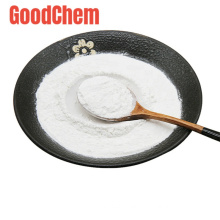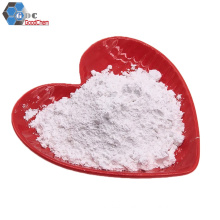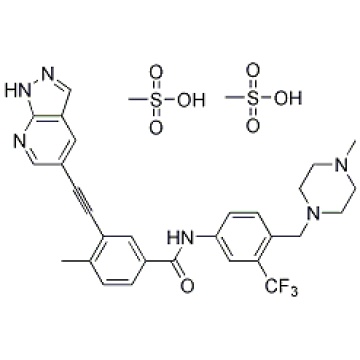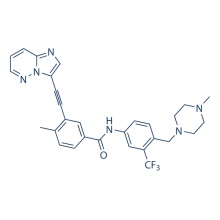.cp_wz tabla {borde superior: 1px sólido #ccc; borde izquierdo: 1px sólido #ccc; } .cp_wz table td {borde derecho: 1px sólido #ccc; borde inferior: 1px sólido #ccc; padding: 5px 0px 0px 5px;} .cp_wz table th {border-right: 1px solid #ccc; border-bottom: 1px solid #ccc; relleno: 5px 0px 0px 5px;} \ n Peso molecular: \ n 724.77 GZD824 Dimesylate es un nuevo inhibidor de Bcr-Abl biodisponible por vía oral para Bcr-Abl (WT) y Bcr-Abl (T315I) con IC50 de 0.34 nM y 0.68 nM, respectivamente. \ n Actividad biológica GZD824 inhibe de forma potente el crecimiento de células Ba / F3 que expresan Bcr-Abl de tipo salvaje con IC50 de 1,0 nM. Altamente consistente con la inhibición de la quinasa bioquímica y la estrecha afinidad de unión a proteínas, GZD824 también inhibe fuertemente la proliferación de células Ba / F3 que expresan el mutante Bcr-AblT315I y otros 14 mutantes Bcr-Abl relevantes para la resistencia. Además, GZD824 suprime eficazmente la activación de Bcr-Abl, así como Crkl y STAT5 aguas abajo de una manera dependiente de la concentración en células de CML K562. GZD824, a dosis de 5 y 10 mg / kg / día, inhibe de manera dependiente de la dosis el crecimiento tumoral en el xenoinjerto tumoral K562 y el modelo de xenoinjerto Ku812 sin mortalidad o pérdida corporal significativa. Además, GZD824 (20 mg / kg / día) suprime el crecimiento tumoral en ratones que portan células Ba / F3 aloinjertadas que expresan Bcr-AblWT y Bcr-AblT315I. Protocolo (solo como referencia) Ensayo de quinasa: [1]
|
FRET-Based Z′-Lyte Assay Detecting Peptide Substrate Phosphorylation
|
The kinases ABL1, ABL1(E255K), ABL1 (G250E), ABL1(T315I), and ABL1(Y253F) are P3049, PV3864, PV3865, PV3866, and PV3863 are full-length human recombinant protein expressed in insect cells and histidine-tagged. Inhibition activities of inhibitors against Abl1 and its mutants are performed in 384-well plates using the FRET-based Z′-Lyte assay system. Briefly, the kinase substrate is diluted into 5 μL of kinase reaction buffer; and the kinase is added. Compounds (10 nL) with indicated concentrations are then delivered to the reaction by using Echo liquid handler, and the mixture is incubated for 30 min at room temperature. Then 5 μL of 2X ATP solution is added to initiate the reaction, and the mixture is further incubated for 2 h at room temperature. The resulting reactions contains 10 μM (for wild-type Abl1, and mutants Y253F, Q252H, M351T, and H396P) or 5 μM (for mutants E255K, G250E, T315I) of ATP, 2 μM of Tyr2 Peptide substrate in 50 mM HEPES (PH 7.5), 0.01% BRIJ-35, 10 mM MgCl2, 1 mM EGTA, 0.0247 μg/mL Abl1, and inhibitors as appropriate. Then, 5 μL of development reagent is added, and the mixture is incubated for 2 h at room temperature before 5 μL of stop solution is added. Fluorescence signal ratio of 445 nm (Coumarin)/520 nm (fluorescin) is examined on an EnVision Multilabel Reader. The data are analyzed using Graphpad Prism5. The data are the mean value of three experiments.
|
Ensayo celular: [1]
|
Cell lines
|
Ba/F3 cells expressing wildtype and mutant Bcr-Abl
|
|
Concentrations
|
0-50 μM
|
|
Incubation Time
|
72 hours
|
|
Method
|
Cells in the logarithmic phase are plated in 96-well culture dishes. Twenty-four hours later, cells are treated with the corresponding compounds or vehicle control at the indicated concentration for 72 h. CCK-8 is added into the 96-well plates (10 μL/well) and incubated with the cells for 3 h. OD450 and OD650 are determined by a microplate reader. Absorbance rate (A) for each well is calculated as OD450 – OD650. The cell viability rate for each well is calculated as V% = (As – Ac)/(Ab – Ac) × 100%, and the data were further analyzed using Graphpad Prism5. The data are the mean value of the three experiments. As is the absorbance rate of the test compound well, Ac is the absorbance rate of the well without either cell or test compound, and Ab is the absorbance rate of the well with cell and vehicle control.
|
Estudio con animales: [1]
|
Animal Models
|
Mice xenograft or allograft tumor models using K562 and transformed Ba/F3 cells expressing native Bcr-Abl or Bcr-Abl mutants.
|
|
Formulation
|
1% DMSO, 22.5% Cremophor, 7.5% ethanol, and 69% normal saline
|
|
Dosages
|
~20 mg/kg
|
|
Administration
|
oral gavage
|
|
Solubility
|
Saline,
20 mg/mL
|
|
* Please note that Selleck tests the solubility of all compounds in-house, and the actual solubility may differ slightly from published values. This is normal and is due to slight batch-to-batch variations.
|
Conversión de diferentes modelos de animales basados en BSA (valor basado en datos del Borrador de Directrices de la FDA)
|
Species
|
Baboon
|
Dog
|
Monkey
|
Rabbit
|
Guinea pig
|
Rat
|
Hamster
|
Mouse
|
|
Weight (kg)
|
12
|
10
|
3
|
1.8
|
0.4
|
0.15
|
0.08
|
0.02
|
|
Body Surface Area (m2)
|
0.6
|
0.5
|
0.24
|
0.15
|
0.05
|
0.025
|
0.02
|
0.007
|
|
Km factor
|
20
|
20
|
12
|
12
|
8
|
6
|
5
|
3
|
|
Animal A (mg/kg) = Animal B (mg/kg) multiplied by
|
Animal B Km
|
|
Animal A Km
|
Por ejemplo, para modificar la dosis de resveratrol utilizada para un ratón (22,4 mg / kg) a una dosis basada en el BSA para una rata, multiplique 22,4 mg / kg por el factor Km para un ratón y luego divida por el factor Km para una rata. Este cálculo da como resultado una dosis equivalente para ratas de resveratrol de 11,2 mg / kg.
|
Rat dose (mg/kg) = mouse dose (22.4 mg/kg) ×
|
mouse Km(3)
|
= 11.2 mg/kg
|
|
rat Km(6)
|
\ n Información química
|
Molecular Weight (MW)
|
724.77
|
|
Formula
|
C29H27F3N6O.2CH4O3S
|
|
CAS No.
|
1421783-64-3
|
|
Storage
|
3 years -20℃Powder
|
|
6 months-80℃in solvent (DMSO, water, etc.)
|
|
Synonyms
|
|
|
Solubility (25°C) *
|
In vitro
|
DMSO
|
100 mg/mL
(137.97 mM)
|
|
Water
|
100 mg/mL
(137.97 mM)
|
|
Ethanol
|
<1 mg/mL
(
|
|
In vivo
|
Saline
|
20 mg/mL
|
* <1 mg/ml means slightly soluble or insoluble.
* Please note that Selleck tests the solubility of all compounds in-house, and the actual solubility may differ slightly from published values. This is normal and is due to slight batch-to-batch variations.
|
|
Chemical Name
|
Benzamide, 4-methyl-N-[4-[(4-methyl-1-piperazinyl)methyl]-3-(trifluoromethyl)phenyl]-3-[2-(1H-pyrazolo[3,4-b]pyridin-5-yl)ethynyl]-, methanesulfonate (1:2)
|
Calculadora de molaridad Calculadora de dilución Calculadora de peso molecular
Grupos de Producto : Angiogénesis > Inhibidor de Bcr-Abl









